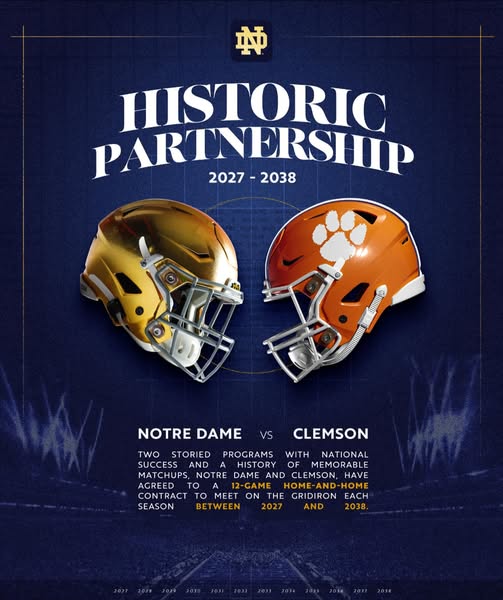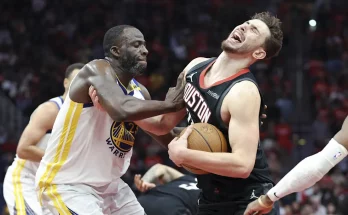In a bold move that’s sending shockwaves through the college football landscape, two of the sport’s most iconic programs—Notre Dame and Clemson—have agreed to a historic 12-game home-and-home series, marking a new era in powerhouse matchups and redefining the future of regular season scheduling.
The agreement, which will span over the next two decades, locks in annual meetings between the Fighting Irish and the Tigers. It’s a series that guarantees intensity, tradition, and elite-level football for the foreseeable future. For fans, players, and coaches alike, the anticipation has already begun. This isn’t just another scheduling announcement—this is a monumental pact between two football blue bloods, the kind of long-form rivalry we rarely see developed outside of conference play.
For Notre Dame, an independent in football since its inception, the deal solidifies yet another strategic step in its modern scheduling philosophy. Athletic Director Pete Bevacqua, in his first major announcement since taking over for Jack Swarbrick, called the agreement “a visionary move rooted in mutual respect and a shared passion for the game.” Clemson Athletic Director Graham Neff echoed the sentiment, praising the partnership as “a win for student-athletes, fans, and the sport itself.”
These aren’t just words—they reflect a significant pivot in the college football scheduling arms race. As realignment reshapes conferences and traditional rivalries get lost in the shuffle, Notre Dame and Clemson have decided to take destiny into their own hands. Twelve games. Alternating home stadiums. A commitment that spans from South Bend to Death Valley and back again.
The history between the two schools is still relatively young but already rich. Their first meeting came in 1977, when Joe Montana led Notre Dame to a 21-17 victory in South Carolina. The matchup has only grown in prominence since then, most notably during the College Football Playoff era. Clemson knocked off Notre Dame in a 2015 thriller in the rain and again in the 2020 ACC Championship Game. The Irish, however, returned the favor that same 2020 regular season, delivering Clemson its only regular season loss with an unforgettable double-overtime win in South Bend.
Each of those games felt like a heavyweight title bout. Each one carried national implications. Now, imagine that kind of energy—every year, alternating between Touchdown Jesus and Howard’s Rock.
This deal promises not only elite football but also long-term relevance. Notre Dame and Clemson are two of the most consistently successful programs in modern college football. Since 2015, Clemson has reached the College Football Playoff six times, winning two national titles under Dabo Swinney. Notre Dame, under Brian Kelly and now Marcus Freeman, has also made multiple New Year’s Six appearances and one CFP berth, regularly finishing in the AP Top 10.
The annual matchup virtually guarantees a high-profile, nationally televised game, one that could impact conference standings, playoff rankings, and recruiting battles. It’s a strategic masterpiece. Clemson, a cornerstone of the ACC, ensures a marquee non-conference opponent. Notre Dame, proudly independent, gains another annual blue-chip program to pair alongside its traditional slate of USC, Stanford, Navy, and Big Ten foes.
In an era where television rights deals and playoff berths often dictate decision-making, this series offers stability, tradition, and spectacle—without the chaos of conference realignment. Instead of waiting for a bowl game or postseason bracket to deliver Notre Dame vs. Clemson, fans now have it built into the calendar.
There’s also something poetic about it. South Bend’s storied golden helmets will shine under the lights of Memorial Stadium. The Tigers will make the iconic walk through Notre Dame Stadium’s historic tunnels. Cultures will clash. Fanbases will travel. National narratives will be born on crisp autumn Saturdays. With each passing year, what was once a sporadic meeting becomes one of college football’s definitive rivalries.
From a recruiting standpoint, the ripple effects are undeniable. Notre Dame and Clemson regularly battle over top-tier talent, especially in the Southeast and Midwest. High school stars will now know, with certainty, that they’ll get to play in at least one of the sport’s most electric venues every season. For many elite prospects, that may be a tipping point.
And don’t overlook the impact on media. ESPN, NBC, and potentially new streaming partners will scramble to broadcast these games, knowing full well that Notre Dame vs. Clemson is appointment television. College GameDay might as well block out these weekends in advance.
Behind the scenes, sources say the talks between Notre Dame and Clemson began quietly over a year ago. Mutual interest turned into mutual ambition. Logistics gave way to legacy. When it was time to finalize the deal, there was no hesitation. Both sides recognized the opportunity—and the responsibility—to shape the future of the sport in a way that puts fans and athletes first.
The start date of the series is expected to begin later this decade, though an exact timeline is still being finalized. What is known is that both schools have cleared future scheduling windows to accommodate the agreement. That may mean adjusting existing rivalries or dropping lower-tier non-conference opponents, but for both programs, it’s a tradeoff worth making.
While other top-tier programs scramble to manage bloated conference schedules or play only occasional high-profile games, Notre Dame and Clemson are opting in to consistency. This isn’t about one-year excitement—it’s about building a legacy. Every season, regardless of what else is happening in the college football universe, fans will have one guaranteed matchup that delivers at the highest level.
The game-day experience itself will be unforgettable. Imagine 80,000 fans in Clemson, roaring as the team runs down the hill. Or 77,000 packed into Notre Dame Stadium, with the Victory March echoing through the stands as the Irish take the field. These aren’t just football games—they’re pilgrimages.
But even more compelling is the idea that this series could evolve into something even greater. As playoff formats expand and college football continues to reshape itself, consistent high-level regular-season matchups could become the defining metric for playoff invitations. A 12-game series like this one could not only elevate the status of both programs but also influence the broader national conversation about what college football should look like in the 2030s and beyond.
At its core, this is what college football should be: two proud institutions, steeped in tradition, choosing to test themselves against the very best every year. It’s competitive excellence. It’s cultural significance. It’s everything that makes the sport great.
And it’s just the beginning.
With this landmark agreement, Notre Dame and Clemson aren’t just adding games to the schedule—they’re crafting a new chapter in college football history. One where legacy isn’t built behind closed doors or through manipulated rankings, but on the field, in front of sold-out stadiums and millions of viewers.
This rivalry will be a proving ground. It will birth legends. And it will serve as a beacon for what the sport can be when vision, courage, and tradition come together.
Powerhouses, indeed. And now, for the next 12 meetings, united by a shared ambition: to elevate the game, together.


